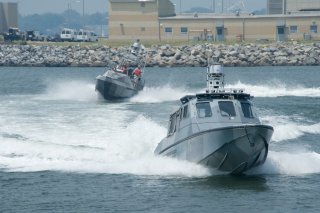The Navy Wants its Sailors to ‘Talk’ With Robotic Warships
Concerned that the advent of unmanned surface ships can result in collisions with manned vessels, the Navy wants technology that will enable robot ships that talk like humans.
Here's What You Need To Remember: What’s interesting here isn’t just the notion of robot ships that talk like humans. The fact is that many human beings distrust intelligent robots. But an autonomous ship that can talk in human – or at least human-like speech – might make flesh-and-blood sailors less nervous about encountering robot vessels at sea.
Concerned that the advent of unmanned surface ships can result in collisions with manned vessels, the Navy wants technology that will enable robot ships that talk like humans.
The goal is to enable human bridge crews to converse with robot ships using normal speech over VHF radio.
“The nautical rules of the road (COLREGS) provide clear guidance for encounters between two vessels, but they do not directly specify what should happen when three or more vessels come in close proximity to each other at nearly the same time,” according to the Navy research solicitation. “Mariners commonly deal with such situations by communicating via VHF Bridge-to-Bridge radio. Current Unmanned Surface Vehicles (USVs) have COLREGS reasoning engines, but they cannot incorporate information from Bridge-to-Bridge conversations, nor can they reply to simple maneuver proposals.”
Technology already exists to convert voice to text and vice versa, while unmanned ships have COLREGS programmed into their AI to enable them to follow the maritime rules of the road. And the Navy wants to use all of this to create virtual sailors that will communicate like real ones.
“The Navy seeks an integrated solution that will enable a USV to act much like a human mariner,” the Navy said. “In particular, the USV should be able to understand secure Bridge-to-Bridge radio transmissions, incorporate their meaning into its world model, develop appropriate maneuvering plans, and respond via voice on the Bridge-to-Bridge radio.”
Phase I of the project calls for a system that can respond to a routine signal such as, “Sea Hunter, this is Sun Princess; propose a port-to-port passage.” It will feature English-language transmissions from native speakers. Sea Hunter happens to be the Navy’s experimental yacht-sized robot ship, designed to autonomously detect and track ultra-quiet diesel submarines.
Phase II will tackle the tricky problem of non-native speakers communicating in English, which is common occurrence at sea. The goal is to “recognize English spoken by non-native speakers, and generate English replies to proposed maneuvers.” Cognizant of safety concerns about autonomous ships, the Navy specifies that “Phase II testing may be accomplished on a manned surrogate vessel with a stand-alone autonomy system running on a laptop or other computer but not actually controlling the vessel’s movements. Phase II testing may also be accomplished on a USV that is temporarily manned for evaluation and safety reasons.
Phase III will see limited at-sea trials with an eye toward fitting the technology on several Navy programs to develop unmanned surface ships, including the Medium Unmanned Surface Vehicle (MUSV) and the Large Unmanned Surface Vehicle (LUSV).
The Navy suggests that talking robots will also be useful to commercial ships. “The civilian market for unmanned vessels appears poised for take-off, and such vessels will need to be able to function even when satellite links to remote oversight facilities ashore are inoperative. Additionally, this technology can be used on minimally manned vessels and pleasure craft as an aid to a human operator.”
What’s interesting here isn’t just the notion of robot ships that talk like humans. The fact is that many human beings distrust intelligent robots. But an autonomous ship that can talk in human – or at least human-like speech – might make flesh-and-blood sailors less nervous about encountering robot vessels at sea.
Michael Peck is a contributing writer for the National Interest. He can be found on Twitter and Facebook. This article first appeared in December 2019 and is being republished due to reader interest.
Image: Flickr.

